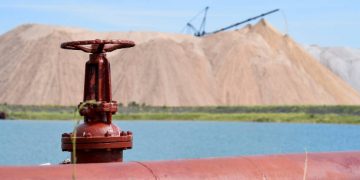Energy Fuels, a producer of uranium and rare earth elements (REEs), is actively enhancing its supply chain to source monazite for processing into rare earth oxides at its White Mesa mill in the United States, according to Mark Chalmers, the company’s president and CEO. Over the past year, Energy Fuels has expanded its operations globally by acquiring significant interests in several heavy mineral sands (HMS) projects. These include the Bahia project in Brazil, which is progressing towards production, a 49% stake in the Donald mineral sands project in Australia, and the recent acquisition of the Toliara project in Madagascar. Collectively, these projects are expected to provide the White Mesa mill with up to 50,000 tonnes per year of monazite by 2026 to 2028.
This strategic expansion will enable Energy Fuels to extract an estimated annual production of up to 5,000 tonnes of neodymium and praseodymium (NdPr) oxide, 200 tonnes of dysprosium oxide, and 70 tonnes of terbium oxide from the processed monazite. Chalmers highlighted the importance of these acquisitions in achieving the company’s goal of becoming a low-cost, world-scale producer of rare earth oxides. “Securing our own supply chain for monazite is essential for controlling costs and production schedules,” Chalmers stated.
The recent proposal to acquire ASX-listed Base Resources, which owns the Toliara project, marks a significant step in Energy Fuels’ diversification strategy. The Toliara project is noted for its large scale, low projected costs, and high-quality minerals such as ilmenite, rutile, and zircon, which are independent of monazite and REEs. Energy Fuels’ White Mesa mill, which now hosts the largest rare earth separation circuit outside China, recently underwent upgrades to enhance its processing capabilities. The mill’s Phase 1 circuit is designed to produce between 800 to 1,000 tonnes per year of NdPr.
In the upcoming second quarter, the company plans to process stockpiled monazite and expects to produce approximately 25 to 35 tonnes of separated NdPr oxide and 10 to 20 tonnes of heavy mixed rare earth concentrate as it commissions the new circuit. Following the NdPr processing run, Energy Fuels will focus on processing alternate feed materials and conventional ore for uranium recovery through mid-2026.
By 2026 or 2027, Energy Fuels anticipates receiving significant quantities of monazite from its newly secured mineral sand projects and aims to have a dedicated monazite crack-and-leach facility completed or under construction. Chalmers concluded, “We are carefully aligning mill and mine schedules to optimize and diversify production of both uranium and rare earths, ensuring that the capacity for each is not compromised.”
Find the best supply chain news at The Supply Chain Report. Free international trade tools are available at ADAMftd.com.
#EnergyFuelsNews #RareEarthNews #RareEarthNews #MineralSands #ResourceManagement

















